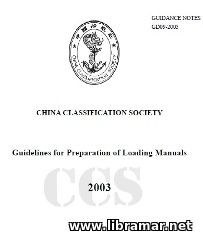 Officially published guidance notes by China Register guiding readers through the entire process of preparation of loading manual. Literally all aspects have been covered in the pages of these Guidelines providing the approval conditions to be taken into account, contents, forms and samples for the manuals to be used by the ship designers and ship owners with required assistance when preparing the loading manuals for the vessels conducting international voyages.
Ship masters will find inside necessary instructions for mastering and controlling the loading process considering stability of the ships and their strength, keeping them within allowable ranges. The requirements contained in this document are corresponding to the provisions of the internationally recognized regulatory documents including conventions and codes and IACS publications.
Note that the relevant Flag requirements shall also be complied with in addition to what is stated in the Guidelines. Five chapters of the guidebook provide general information and cover loading conditions, longitudinal and local strength of ships, and stability information. Details and contents of loading manuals are provided in the appendices together with other useful information.
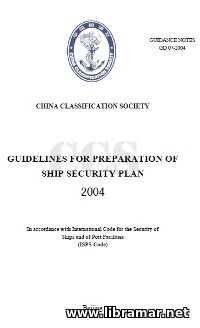 The official CCS Guidelines to be used when preparing the ship security plan; the content is in line with the ISPS Code. Starting with the introductory information, list of abbreviations and definitions used throughout the document, the authors proceed to the general requirements to be taken into account and relevant ship security plan preparation criteria.
The next section of the booklet is dealing with the content and record requirements. Finally, the booklet concludes with the information on preparation of the ship security plan, approval responsibility and instructions on how the sample security plan shall be used. Ship security is the status that is reached once the designated vessel together with the crew members, equipment and cargo on board and all operations are duly protected - it means that they are protected from any sort of terrorism and other illegal activities.
The ISPS Code has been mandated with the ultimate purpose to establish, implement, maintain and further continuously improve the security system of the ship enabling the shipping company and the ship to control the risk associated with maritime security and enhance the outcome. In short, the SSP is one of the most important documents on board and its preparation is a matter of highest importance.
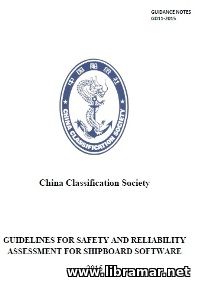 The present publication is the China Register guide addressing the safety and reliability assessment of the software installed in the computer systems on board ship, including PEC, i.e. programmable e-systems, specifying applicable technical requirements in the development and testing of the software, its authentication and production of the software, and its further maintenance.
Numerous requirements applicable to the shipboard hardware are also specified in this document. All of the requirements mentioned above should be treated together with the relevant technical requirements. The authors of this guidebook have mainly focused on the software development lifecycle, adopting the V model as the development model. There are eight chapters in this guide.
While the first chapter describes the scope of the guide, the rest of the chapters provide normative reference documents, abbreviations and terms used throughout the text, categorization of the shipboard computer systems and system lifecycle, lifecycle of the software development, and information on the test and verification procedure. Three appendices cover the inspections and tests, low complexity systems and their evaluation, and various technical recommendations related to the design and implementation stages...
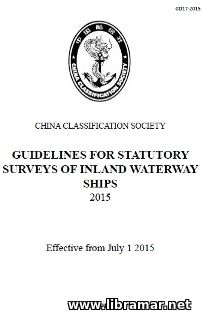 The officially released China Register guidelines for statutory surveys conducted on inland waterway vessels. The set of books consists of nine volumes. The first volume contains general provisions including surveys and certificates as well as assessment methods used for the classification of service area and methods of estimation of significant wave height.
The second volume provides the scope of initial, annual, intermediate and renewal surveys for compliance of the vessels with the requirements of international conventions and annexes. The other seven volumes making the package are dealing with the tonnage measurement and load lines, surveys and transportation of dangerous goods on board inland waterway ships, construction and shipboard equipment used for the prevention of environment pollution from the ships, accommodations for the crew members and passenger quotas.
The guidebooks will be of great practical use for the crew members, owners and operators of the vessels classed by China register who may use the information contained in these volume when preparing their ships to the forthcoming surveys and in general for keeping them compliant with all relevant requirements.
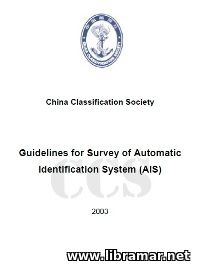 These guidelines released by the China Register of Shipping stipulate the appropriate standards of AIS, standing for the Automatic Identification Systems installed on ships, the requirements to be complied with during the inspection of marine product, installation survey and subsequent surveys in service, as well as relevant testing methods.
Subject systems are intended to effectively contribute in the safety of marine navigation, protection of the marine environment and VTS, i.e. Vessel Traffic Service. This is done by satisfying the functionalities including ship-to-ship mode of operation to prevent collisions and coastal states obtaining the information relating to the vessels and cargoes transported on them.
The content of the guidebook is arranged in six chapters staring with the introduction. Two following chapters contain the technical and performance requirements applicable to the AIS systems. The rest of the chapters are devoted to the type approval and marine product inspection requirements including plans and documents to be approved, installation survey requirements, surveys in service, testing methods and test results required. Four appendices provide supplementary information such as block diagram, interface overview etc.
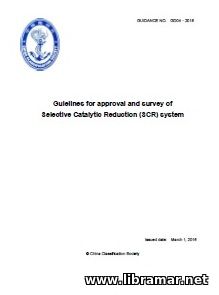 The present guidebook constitutes the Rules developed by the CCS and established the technical requirements as well as survey and testing requirements of SCR, standing for the Selective Catalytic Reduction system. Note that the content of this document shall only apply to the system using the aqueous urea as reductant. Special consideration shall be applied for approval of the systems using liquid ammonia or ammonium hydroxide as reductant.
The paper opens with the description of its application and purpose, relevant normative documentation, definitions, abbreviations and terminology. The main part of the document addresses the plans and documents, and technical requirements that are commonly applicable to such systems, covering raw materials and parts, control system, SCR chamber, supply system and various auxiliary equipment and, finally, redundancy of the SCR system.
The other chapters of the guidelines are dealing with the control and monitoring, safety protection and equipment used for this, technical requirements for the system testing, including sample selection, scaling purpose, model tools and test, type tests and other information. The last chapter is devoted to the technical file of the system and description of the parameter check method. Some additional info is provided in the appendices.
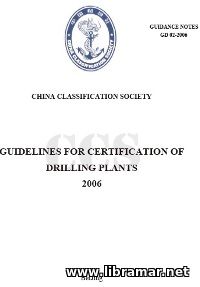 These CCS Guidelines provide the requirements for the design and construction as well as testing and survey of the drilling plants that are located on board fixed and mobile offshore drilling units and other offshore facilities, as applicable. Subject plants together with their systems and equipment shall be designed, constructed and subsequently tested and surveyed as per these Guidelines including all relevant standards; in addition to that, all applicable CCS Rules requirements and Flag Administration requirements shall also be complied with.
The Guidebook is covering all safety aspects of these systems and equipment relating to the drilling and well completion, workover and test operations; note that the content does not cover operation of the plants. The Guidelines cover such systems and equipment as heave compensating/tensioning systems, well control and test systems, marine riser systems, bulk storage, transfer and circulation systems, hoisting systems, rotating systems, pipe handling/BOP handling systems, all structures, control system, electrical systems and other supporting systems. All requirements and procedures to be followed have been specified in the present document.
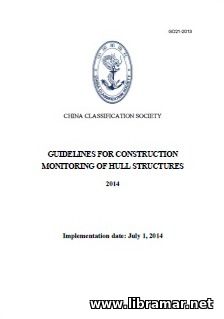 The Chinese Classification Society's Guidelines for Construction Monitoring of Hull Structures are intended to be applied in addition to the applicable requirements for survey of the critical locations within the ship's structure, for the purpose of controls on fit-up, alignment, groove preparation and workmanship to such locations of the relevant hull structures, in order to ensure that those critical locations are being built to both approved construction procedures and to the acceptable quality standards.
The CMP - Construction Monitoring Plan - is used for all parties involved in construction and concerned to focus the attention of knowledge of the ship hull critical locations during her service life. These Guidelines have been divided in four chapters covering general information, monitoring prior to/during/after construction, supplemented with three Annexes addressing critical locations of hull structures, construction monitoring standard for hull structures, and sample construction monitoring plan.
These Guidelines are applicable to all newly constructed oil tankers, bulk carriers and container vessels having a length of 150 or more meters. Throughout the whole service life of the ship, the owners will be held responsible for conducting regular inspections and maintaining critical locations determined before, as per approved construction monitoring plan.
« 1 2 ... 8 9 10 11 12 ... 29 30 » |







